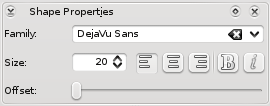Karbon/Tutorials/Artistic Text Shape/fr: Difference between revisions
ChristianW (talk | contribs) Created page with "centrer" |
ChristianW (talk | contribs) No edit summary |
||
| (22 intermediate revisions by 2 users not shown) | |||
| Line 1: | Line 1: | ||
<languages /> | <languages /> | ||
Ce tutoriel | Ce tutoriel présente ce que l'on peut faire avec les <menuchoice>Formes artistiques pour le texte </menuchoice>. Bien que ce tutoriel ait été fait avec '''Karbon''', les formes sont disponibles dans les autres applications '''Calligra''', et fonctionnent de la même façon. | ||
Dans cette leçon, vous allez | Dans cette leçon, vous allez | ||
* créer une forme | * créer une forme avec un texte | ||
* associer une forme à un chemin | * associer une forme à un chemin | ||
{{Tip| | {{Tip/fr|Si un docker n'est pas visible, vous pouvez soit aller sur le menu <menuchoice>Configuration-> Dockers</menuchoice> , ou cliquez-droit sur un titre de docker, et ensuite rendre ce docker visible.}} | ||
== | == Premier pas avec une forme textuelle == | ||
{|class="tablecenter vertical-centered" | {|class="tablecenter vertical-centered" | ||
|[[Image:Add-artistic-text-shape.png]] || | |[[Image:Add-artistic-text-shape.png]] || Pour ajouter une forme textuelle artistique, reportez-vous au docker <menuchoice>Ajouter une forme</menuchoice>, cliquez sur l'icône <menuchoice>Texte Artistique</menuchoice>, et déplacez-la sur le canevas. | ||
|} | |} | ||
Après avoir ajouté la forme, vous voudrez peut-être modifier le texte et afficher quelque chose de plus intéressant. Pour ce faire, vous devez activer l'<menuchoice>outil de forme textuelle artistique </menuchoice>, soit en double-cliquant sur la forme nouvellement créée, soit en sélectionnant [[Image:Artistictext-tool.png|16px]] dans la boîte à outils. Ensuite, vous pouvez changer le texte pour quelque chose comme ça. | |||
[[Image:Boring-artistic-text-shape.png|center]] | [[Image:Boring-artistic-text-shape.png|center]] | ||
{|class="tablecenter vertical-centered" | {|class="tablecenter vertical-centered" | ||
| | | Puisque vous voulez un texte sympa, vous devrez changer la police. On fait cela en changeant les propriétés dans le docker <menuchoice>propriétés des formes</menuchoice>, où vous pouvez changer la police, le style, ainsi que le ''décalage'' (Offset) qui sera utilisé pour contrôler la position du texte sur une forme de chemin. || [[Image:Shape-properties-artistic-text-shape.png]] | ||
|} | |} | ||
Après avoir changé la <menuchoice>police</menuchoice> en "Steve", mis la <menuchoice>taille</menuchoice> à 30 points, et la fonte en <menuchoice>gras</menuchoice>, vous pouvez observer la forme suivante dans votre canevas : | |||
[[Image:Cool-artistic-text-shape.png|center]] | [[Image:Cool-artistic-text-shape.png|center]] | ||
== | == Suiveur de chemin == | ||
C'est encore un texte très droit et plat. Maintenant, nous voulons un texte sinueux. Pour ce faire, nous aurons besoin de créer un chemin, par exemple, en utilisant l'outil de dessin <menuchoice>Chemin à main levée</menuchoice> [[Image:Draw-freehand.png]]. | |||
Vous devriez avoir quelque chose comme ceci : | |||
[[Image:Cool-artistic-text-shape-and-curve.png| | [[Image:Cool-artistic-text-shape-and-curve.png|center]] | ||
Pour associer le texte à la courbe, vous devez activer l'<menuchoice>outil texte artistique</menuchoice> en double-cliquant sur le texte, ou en sélectionnant [[Image:Artistictext-tool.png|16px]]. | |||
Ensuite, si vous déplacez la souris au-dessus de la courbe, vous verrez le curseur se changer en main, vous devrez cliquer deux fois sur la courbe<!--. In the | |||
<menuchoice>Tool options</menuchoice> docker, the <menuchoice>Attach path</menuchoice> icon [[Image:Artistictext-attach-path.png]] is now enabled, and you need to click on it--> | <menuchoice>Tool options</menuchoice> docker, the <menuchoice>Attach path</menuchoice> icon [[Image:Artistictext-attach-path.png]] is now enabled, and you need to click on it--> pour attacher le chemin. En utilisant le décalage du docker <menuchoice>Propriétés de la forme</menuchoice>, vous pouvez ajuster le texte pour obtenir le résultat suivant : | ||
[[Image:Cool-curvy-artistic-text-shape.png|center]] | [[Image:Cool-curvy-artistic-text-shape.png|center]] | ||
Vous pouvez détacher le chemin en cliquant sur [[Image:Artistictext-detach-path.png]]. Vous pouvez <menuchoice>translater</menuchoice>, <menuchoice>tourner</menuchoice> et <menuchoice>modifier</menuchoice> le texte. Si vous changez la courbe, alors le texte sera mis à jour. | |||
[[Category: | [[Category:Bureau/fr]] | ||
[[Category: | [[Category:Tutoriels/fr]] | ||
[[Category: | [[Category:Graphisme/fr]] | ||
Latest revision as of 21:03, 28 June 2020
Ce tutoriel présente ce que l'on peut faire avec les . Bien que ce tutoriel ait été fait avec Karbon, les formes sont disponibles dans les autres applications Calligra, et fonctionnent de la même façon.
Dans cette leçon, vous allez
- créer une forme avec un texte
- associer une forme à un chemin
Premier pas avec une forme textuelle
 |
Pour ajouter une forme textuelle artistique, reportez-vous au docker , cliquez sur l'icône , et déplacez-la sur le canevas. |
Après avoir ajouté la forme, vous voudrez peut-être modifier le texte et afficher quelque chose de plus intéressant. Pour ce faire, vous devez activer l', soit en double-cliquant sur la forme nouvellement créée, soit en sélectionnant ![]() dans la boîte à outils. Ensuite, vous pouvez changer le texte pour quelque chose comme ça.
dans la boîte à outils. Ensuite, vous pouvez changer le texte pour quelque chose comme ça.

Après avoir changé la en "Steve", mis la à 30 points, et la fonte en , vous pouvez observer la forme suivante dans votre canevas :

Suiveur de chemin
C'est encore un texte très droit et plat. Maintenant, nous voulons un texte sinueux. Pour ce faire, nous aurons besoin de créer un chemin, par exemple, en utilisant l'outil de dessin ![]() .
.
Vous devriez avoir quelque chose comme ceci :

Pour associer le texte à la courbe, vous devez activer l' en double-cliquant sur le texte, ou en sélectionnant ![]() .
.
Ensuite, si vous déplacez la souris au-dessus de la courbe, vous verrez le curseur se changer en main, vous devrez cliquer deux fois sur la courbe pour attacher le chemin. En utilisant le décalage du docker , vous pouvez ajuster le texte pour obtenir le résultat suivant :

Vous pouvez détacher le chemin en cliquant sur ![]() . Vous pouvez , et le texte. Si vous changez la courbe, alors le texte sera mis à jour.
. Vous pouvez , et le texte. Si vous changez la courbe, alors le texte sera mis à jour.


